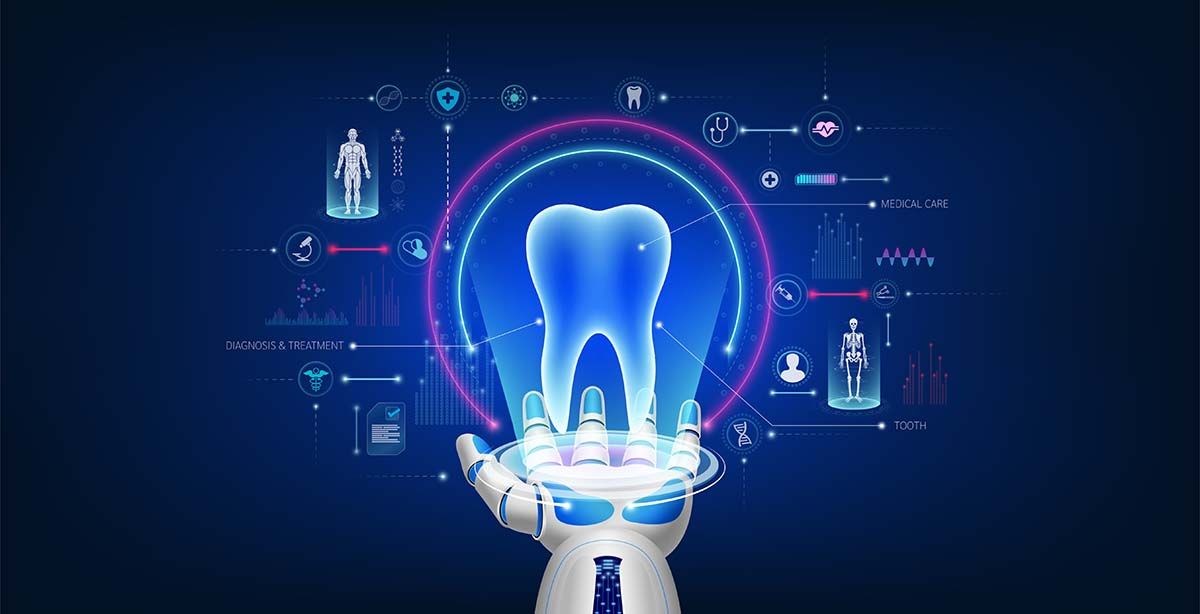How Emerging AI-Enabled Technology Can Revolutionize the Dental Practice
From digital dental assistants to at-home monitoring, artificial intelligence can enhance both the patient and provider experience.
ADISAK / STOCK.ADOBE.COM

For many, discussions about the use of artificial intelligence (AI) either feel too futuristic or stoke fears about independent computers. The reality is much more comforting: AI-enabled tools can be used effectively in the dental industry to enhance the patient experience, streamline administrative and clinical processes, and improve employee satisfaction.
Organizations like Aspen Dental® are at the forefront of adopting and implementing these tools to support both operational and clinical excellence and provide decision-making guidance for patients and providers alike.
Here are a few innovative AI-enabled technologies that are already–or soon will be–enhancing the field of dentistry.
Digital Dental Assistant: Voice-Activated Periodontal Charting
The Digital Dental Assistant currently in use at many Aspen Dental locations allows hygienists to issue vocal commands that are then translated by an AI virtual assistant into updates in a patient’s periodontal chart.
The Digital Dental Assistant acts as an intelligent layer between the hygienist or other provider and the electronic health record. With Digital Dental Assistant, hygienists can speak directly into a microphone fastened to their lapel as they examine a patient and offer a periodontal diagnosis. The AI tool translates the hygienist’s speech to text, then a robotic process automation component types the text into the periodontal chart.
Digital Dental Assistant can also do more than transcribe information. It has the ability to analyze the clinical data inputs, which allows it to generate a health summary to facilitate patient education through conversations between the provider and patient.
Without Digital Dental Assistant, hygienists either have to call for a dental assistant to transcribe the periodontal information into the chart, or they must complete the process themselves, risking cross-contamination as they switch between gloves and keyboards. This AI-enabled technology streamlines the periodontal charting process and reduces the time hygienists must spend on unfavorable administrative tasks.
This tool is a boon for dental assistants, as well. In the clinic, dental assistants perform a wide variety of activities, including taking x-rays, performing scans, and assisting providers and patients. Without the burden of periodontal chart transcription, dental assistants have more time to address other, more pressing duties.
For patients, Digital Dental Assistant reduces the time hygienists must spend on the periodontal exam, which means more efficient appointments. Patients also feel more comfortable speaking with hygienists and asking questions, because the providers are focused only on the patient, instead of on transcribing notes into the computer. Without repetitive tasks that swallow hygienists’ time, they have more bandwidth to focus on the patient and their treatment.
At-Home Oral Health Monitoring Tool
Aspen Dental uses AI technology to analyze the health of patients’ teeth from the comfort of their own homes. Currently deployed in all Aspen Dental locations that offer MottoTM clear aligners, this tool allows patients to use a device provided by their dentist to take pictures of their teeth. The AI tool automatically analyzes the pictures, taking note of oral hygiene, gum health, tooth alignment, and tooth movement. The tool can then recommend either an in-person visit, a telehealth visit, or no visit at all.
The technology empowers clinicians to reduce the number of times a patient has to come to the clinic, which improves the overall experience and enhances convenience. This tool also saves operating chair time, allowing providers to offer quality care to a greater volume of patients.
Clinical Voice-Activated Notes: Reducing Administrative Burden
Similar to Digital Dental Assistant, the technology behind clinical voice-activated notes allows clinicians to speak voice commands that power AI virtual assistants to transcribe those notes into clinical charts automatically. Often, the administrative burden of manual data entry results in incomplete patient records, which can expose organizations to risk and compliance issues. With clinical voice-activated notes, providers can speak into their phones, sync the data with their computers, and drive the AI assistant to type the notes into the patient’s record.
Besides the huge productivity gain for clinicians, this technology also enables more accurate and complete clinical records, a stronger risk and compliance position, and greater time and attention spent on patient interactions.
The Aspen Group has implemented clinical voice-activated notes in its WellNow locations, with the goal of expanding to Aspen Dental in the near future.
AI Diagnostics: A New Frontier
Besides the AI-enabled technologies already in place, there are several in the pipeline that can revolutionize dentistry. One such solution is AI Diagnostics, which will automatically read x-rays, 3D scans, and dental cone-beam computed tomography (CBCT) images. The technology can then diagnose diseases and recommend appropriate treatment.
This technology, when implemented, will be a game changer not only for how dental professionals diagnose patients, but it will also help simplify and improve workflows, allowing doctors and staff to spend their time providing excellent patient care.
Customer-Centric Mindset
Clearly, AI-enabled tools can revolutionize the dental industry. From reducing the administrative burden of repetitive tasks to improving the patient and staff experience, AI can provide a wealth of benefits.
Every new product or technology, including AI, needs to solve a critical problem for the customer in a way that creates differentiation for the organization implementing it.
For an AI solution to be successful, customers–in this case, clinicians and patients–need to be at the center of all stages of development, from ideation to implementation. Customers expect technology to be intuitive and easy to use, and it’s going to become more and more necessary to craft our technology to meet those expectations to cut down the length of training time and encourage better adoption.
Emerging technologies, when implemented well, have the ability to benefit clinicians, staff, patients, and the organization as a whole on many different levels. For the field of dentistry, the right technologies can improve the patient experience while also allowing providers to focus more on patient care and less on the administrative duties that come with it.